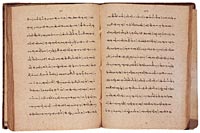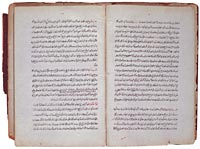WHITE WHALES AND BUGIS BOOKS
|

" Story of a War Between Two Young
Bugis Rajas over a Princess." Coming from South Sulawesi (Belebes),
the Bugis began to migrate
to
the Malay
peninsula
in the
late seventheenth century, fleeing civil war and the loss
of their spice trading network to the Dutch East India
Company. On the Malay peninsula, the Bugis became a major
political force, even founding their own political dynasty
in what is now the state of Selangor. This Bugis manuscript
was one of ten purchased in Singapore by the Wilkes Expedition
in 1842. Written in the Bugis language in an Indic-derived
script, these rare manuscripts are important examples of
nineteenth-century literature of the Bugis diaspora. (Bugis
Manuscript Collection, Asian Division)
|
The Malay world that captured the modern Western imagination
through the writing of authors such as Joseph Conrad and Somerset
Maugham has a long history as a crossroad of commerce. The prosperity
of the early kingdoms in what is now Indonesia and Malaysia was
largely based on trade. Spices from Southeast Asia lured European
traders, who came for commerce and stayed as colonizers.
Indian religions played an important role in the early history
of both insular and mainland Southeast Asia. Kingdoms such as
Srivijaya (seventh to fourteenth centuries) and Majapahit (thirteenth
to sixteenth centuries) grew up shaped by Hindu and Buddhist
beliefs blended with indigenous religious traditions. The conversion
of the ruler of Malacca, another of these kingdoms, to Islam
in the fifteenth century gave tremendous impetus to the spread
of Islam throughout the region. One of the most important early
documents recording this history is the Sejarah Melayu (Malay
Annals), drafted in the Malay state of Johor in 1612 and recopied
early in the nineteenth century. The Sejarah Melayu apparently
existed only in manuscript form until about 1840, when it was
printed in Singapore by an American missionary, Alfred North.
Two editions of this Mission Press version can be found in the
Asian Division's rare book collection. Written in Jawi (Malay
in Arabic script), they are part of the Asian Division's unique
collection of Malay manuscripts and early printed books.
How did the Library become the home of this valuable collection?
It was brought to the United States in 1842 on a sailing vessel
commanded by Lt. Charles Wilkes, a superb sailor-scientist. Wilkes
commanded the U.S. Naval Exploring Expedition that circumnavigated
the globe from 1838 to 1842, concentrating much of its efforts
in the Pacific. The expedition also carried a group of scientists
who charted unknown waters and gathered specimens of everything
from animals to plants to sea shells, most of which later formed
the basis for the Smithsonian's collections. It is difficult
for us, living at the end of the twentieth century, to understand
the excitement the Wilkes Expedition stirred among Americans
of the 1840s, but Wilkes was seen as a discoverer of new worlds,
almost another Columbus. His stern, aloof personality and strong
efforts to promote the image of the U.S. Navy during the voyage,
however, also stirred controversy. One of those fascinated by
the Wilkes drama was Herman Melville, who used the official history
of the expedition as a resource for Moby Dick and modeled
Captain Ahab, the whaling captain obsessed by the white whale,
on Lieutenant Wilkes.
|

Munshi Abdullah bin Abdul Kadir. Hikayat
Abdullah (1843). The Hikayat Abdullah (The
Story of Abdullah) is a valuable source for historians,
both for Abdullah's firsthand descriptions of important
nineteenth- century figures, such as Stamford Raffles,
the founder of Singapore, and for its detailed description
of everyday life in the nineteenth-century Malay world.
As a work of personal observation and description unembellished
with legend and folktales, it was the first attempt by
a local writer at a more Western style of literature.
When the American Exploring Expedition led by Charles
Wilkes was in Singapore in 1842, Wilkes requested that
the missionary Alfred North send a copy of Abdullah's
autobiography to him in the United States. The work was
completed the following year and North forwarded this
manuscript copy, which is in Malay using the Jawi script.
In 1865, the Smithsonian Institution transferred the
manuscript to the Library, making it one of the first
Asian books to enter the collections. (Jawi Manuscript
Collection, Asian Division)
|
The Wilkes Expedition also collected books. When he reached
Singapore in early 1842, Wilkes and the expedition's philologist,
Horatio
Hale, collected Malay manuscripts and early printed books.
They were assisted by Alfred North, the American missionary based
in Singapore. Among those books were unique manuscripts written
in the Bugis script. The Buginese, from South Sulawesi, ran an
extensive seaborne trading network, of which Singapore became
a central part. These Malay and Bugis manuscripts first went
to the Smithsonian but in 1865 the Smithsonian transferred its
books, including this material, to the Library of Congress. The
Manuscript Division holds the papers and journals of a number
of participants in the Wilkes Expedition, including Wilkes himself;
his second in command, William Leverreth Hudson; and one of the
Expedition's sailors, Joseph G. Clark.
Of particular interest to scholars of Indonesia are some of
the early manuscript maps of the Indonesian archipelago in the
Geography and Map Division. One set of fourteen maps was previously
owned by Gilbert Elliot, the First Earl of Minto, who served
as Governor General of India from 1807 to 1814 and who led Britain's
1811 expedition to expel the Dutch from the island of Java. Another
set consists of eighteenth-century Spanish manuscript maps showing
coastal areas, primarily of Sumatra.
|